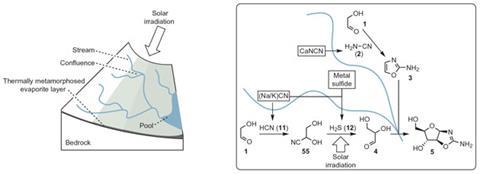Scientists propose that key biomolecules appeared simultaneously from a hellish cyanide and sulfide mix

UK chemists have found a reaction network that they believe shows that ‘pretty much everyone’ working on life’s molecular origins is wrong – but also ‘right, in a sense’. Until now, the field has warred over which biomolecule emerged first. But John Sutherland’s team at the Medical Research Council (MRC) Laboratory of Molecular Biology in Cambridge has found the different types may have appeared simultaneously.1
The chemists have mapped reactions producing two- and three-carbon sugars, amino acids, ribonucleotides and glycerol. Respectively, these are fuel for metabolism, building blocks for proteins, for ribonucleic acid (RNA) molecules that carry genetic information and for fats that form cell membranes. The map shows how they could have formed on Earth’s surface from just hydrogen cyanide, hydrogen sulfide and ultraviolet light from the Sun.
‘What fascinates me is that you get so many biological molecules and so little else,’ Sutherland tells Chemistry World. ‘The implication is that the environment provided those molecules and it just so happened that they worked, and that’s why we’re here.’
Sutherland has seen ‘fights’ at conferences over whether RNA, cell membranes or metabolism came first. In 2009, his team made ribonucleotides from hydrogen cyanide derivatives, but were unable to say where these starting materials originated.2 However, the MRC chemists gained insights by considering the hellish environment the reactions might be happening in. Life emerged when meteorites were pounding the planet and cyanide can be formed from the reaction of carbon in meteorites with nitrogen in the air. Meteorites also often contain iron sulfide.
Coincident creation
‘We realised that lots of hydrogen cyanide would almost certainly end up making hydrogen sulfide, because metal sulfide ores dissolve in cyanide solutions,’ Sutherland explains. In 2013 he and Dougal Ritson showed hydrogen sulfide and hydrogen cyanide could make sugars for metabolism.3
The chemists have now shown these conditions produce over 50 different molecules. Glycerol and 11 different amino acids have joined previously-synthesised biomolecules including cytidine and uridine ribonucleotides and small sugars. Many of these reactions yield 40–70% of the maximum product possible. This compares to amino acid yields of less than 1% in the famous Miller-Urey origin-of-life experiments that zapped electricity through a mixture of methane, ammonia, hydrogen and water. ‘This chemistry is incredibly efficient,’ Sutherland says.
That efficiency comes partly from adding reagents one after another, rather than mixing them all. The MRC team justifies this by suggesting water could have flowed down a slope, carrying different molecules into separate streams and pools.
University College London, UK, origin-of-life biochemist Nick Lane calls the reaction network ‘impressive chemistry’ and says Sutherland is ‘building a coherent set of ideas’. However he says he doesn’t buy the overall scenario. ‘Firstly, the network bears no resemblance to modern biochemistry. The entire network would have had to be overwritten. Second, I find the geochemical context improbable. It calls on very high cyanide concentrations and there’s no evidence to back that up.’ Lane adds that this study shows it’s ‘not so hard’ to generate complex metabolic networks. ‘The onus is on those who disagree with this particular context to do equivalent experiments [simulating] more realistic environments. This we are trying to do.’
Terry Kee from the University of Leeds, UK, agrees that there are issues surrounding the chemistry and scenario envisioned, but nonetheless calls the work ‘highly significant’ and ‘extremely elegant’. ‘For me, the specifics of the geological context are less important than demonstrating complex convergent chemistry could take place in such an environment,’ he says.
Sutherland notes that until this study, theoretical early Earth scenarios have rarely been backed by biomolecular evidence. ‘Letting chemistry indicate the geochemistry seems more reasonable than just guessing,’ he comments.












No comments yet